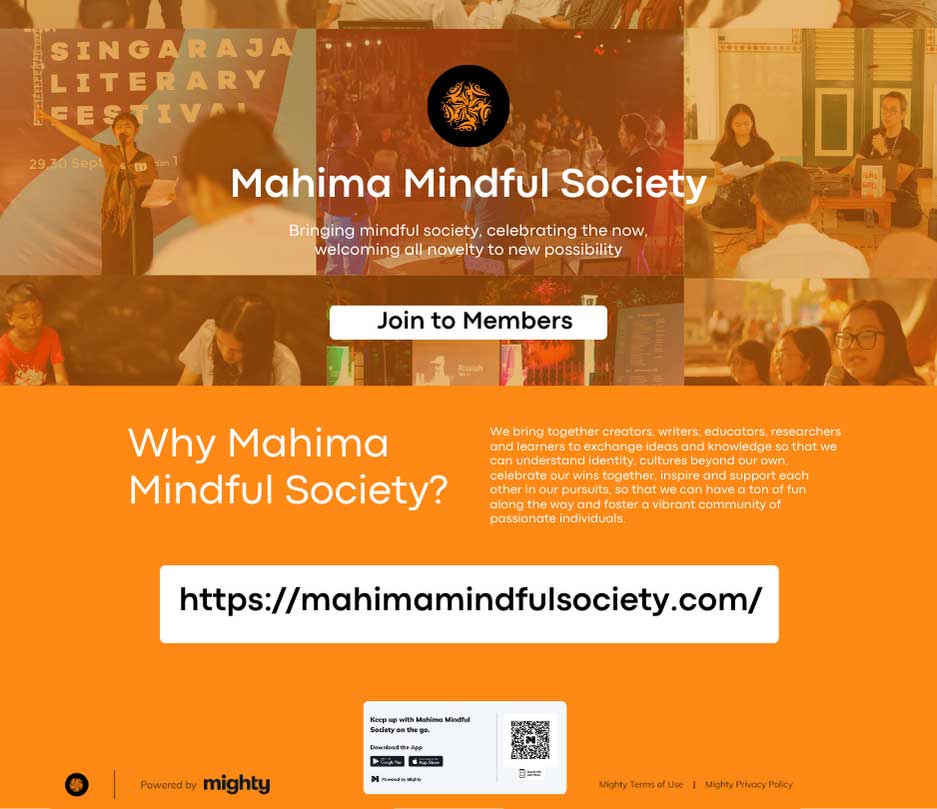- Title : Waking Up for the First Time
- Author : Lala Bohang
- Publisher : PT Simpul Aksara Grup
- ISBN : 978-602-51679-5-9
- Year : 2021
Let me read you a part of writing from Waking up for The First Time by Lala Bohang where you can relate (or not) to your mood.
It’s absurd how things around me become a mere repetition without process that I can quietly observe. Repetitiveness becomes a default feeling, an emotion, and sometimes, the pain on my back or my weekly migraine.
This quote reminds me of the mindlessness state-the state of being repetitive, unaware, careless, detached from the context, and uncritical. Where things go by moment per moment without meaning.
So here, Lala Bohang is trying to give picture or image of a character that is imperfect in some ways, however, she sees the character in a mindful manner. It is the metaphor of reality, where reality is presented in different perspective, where the character is observed more carefully, more mindfully, and non-judgmentally.
Reading Lala Bohang is a journey to yourself-it is a self-care book, self-observed book, self-healing book, where the journey can be started from anywhere. I started reading the book from the last page, to the previous page, jump to the start, to the middle, and back to the end. This is a journey to find yourself, you can start from scratch, from emotion, from observation, from moment to moment.
For me, this book is a long metaphor, a representation of a life in microscope, in microhistory, that focuses on personal events, personal feelings, and personal perspective. I observed that Lala mindfully arranges the events from metaphors, the imagery, the sound and senses of the writing, that I regard this as a free verse poetry that represents the feelings of character in a deeper way.
Not only the words, she also makes it beautiful visually and emotionally. I found it pleasing when she has only curvy lines and along the lines the words say “For my two thousand eighteen’s bed the most peaceful bed I ever slept in”.
How many of us can expect the praises page will go to a bed? Not a family, not a loved one, but to a specific bed in a specific year.
So, we go on closer to the content of the book, there are sixteen stories altogether presented in this book. One that I love the most is “I Refuse to Sleep so I Can Be Happy for a While”. This is a touching story about a character, a woman, that found another woman, a married woman, and fell in love. A woman that never feels love deeper than that feeling, naturally soft and comforting. There is no sexual intercourse just soft kiss and lovely conversations, lovely moments shared together. Until one day, the woman’s husband found out then stop their relationship. Years later, the character got married and have a normal life. Only one thing, she is mindless about everything. She loses the clues of life, everything seems normal and mindless. The only thing she missed, the days with her girlfriend, in the past.
Maybe this is a simple story, but maybe this also happens around us without our notice. Feeling is the most absurd thing and we sometimes unaware of its presence until we found love, or lost it once.
Lala confirmed that during pandemic of covid-19 she entered a new world she barely expects to have, a space where she could look closer to herself and observed her past in a bit more detailed. She jumped into her past, and remembers almost all moments she had with her caregivers, parents and family. One of her stories is very impressive, about an insect that lives in her ear. The moment where the insect was in her ear creates a memory not only about her response to the insect, but to the moment of her parents getting closer together to help her, which she found interesting.
I see that mindfulness comes all the way through her writing. As opposed to mindlessness, Lala’s writing is a result of long practice of mindfulness. Some facts that I found relevant to Langer and Moldoveanu (2000) research on mindfulness are; awareness of the present, sensitivity to context, and diversity. The awareness of the present is shown in her mindful observation on moments, both in imagery, sound and senses. Sensitivity to context we can see in her deep attachment to the setting, atmosphere of the setting, things around her, including her relationship with her bed. The context seems very personal but that is what is meant by looking at deeper to inner-self. That’s how self is built. Third, diversity. Diversity allows us to realize that having more than one perspective is very important. The more we have the perspectives, the more we have the knowledge and the understanding. In the pursuit of knowing, we sometimes tend to be judgmental, however if we have multi perspectives, the tendency of being judgmental is smaller.
Back to the book, I love the idea that the character Lala develops is not a perfect character. She is imperfect and realizes her imperfections. We can see it in the page fourty-nine.
But honestly, it doesn’t matter. Because in the end, we will only pursue the minimal, like usual. We will acknowledge and constantly celebrate the unimportant, ignoring the consequences, regret our decisions,…
Here I believe, we sometimes feel the same way, we try hard, but end up doing minimal thing instead of the best. And this is one of the imperfections that we realize. So, how do we deal with that. This is the way we see things mindfully. I also found some pageless part. Those pageless part has words such as.
Doubtful noise
Emotions with unknown labels
Daily affirmations
Why does she put doubtful noise in a blank page? Does she want to show that in a blank space, there is a loud noise. In an empty and quiet place, there is a loud noise. Where does the sound come from. The head? The hearts? The ears?
At the end, if there is something i could describe fairly about this book I would say, this is a mindful mystery book where all your knowledge Will not be the main direction to understand the whole thing because the idea is not the whole but the pieces that make it a whole. So, of course all our senses will be stimulated to witness the entire words, watch moment after moment and got a bit of surprise here and there.
We are not given any limitations on who we want to be in the pursuit of knowing. Rather, it is an open window wishes to be interpreted once you entered in. Waking you up when you don’t realize you haven’t got the chance to observe the meticulous thing around you. You are forced to look deeper and deeper as you read. The more you read the more you are dragged into the sense of possibilities. Welcome to the reality of imagination, and imagination of reality. [T]





















![Kampusku Sarang Hantu [1]: Ruang Kuliah 13 yang Mencekam](https://tatkala.co/wp-content/uploads/2025/01/chusmeru.-cover-cerita-misteri-120x86.jpg)










